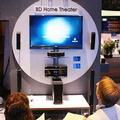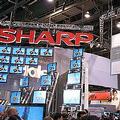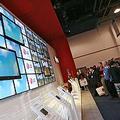 2009年消費性電子大展的參展產品,顯示業者正逐漸實踐其製造更環保產品的諾言。
2009年消費性電子大展的參展產品,顯示業者正逐漸實踐其製造更環保產品的諾言。
該展覽在1月11日結束,超過2,700個參展廠商推出最新數位娛樂、高效能音響、電視、列印及照相器材、電子遊戲和通信設備。從趨向輕薄的設計概念,到生產、包裝,和回收再利用,電子產業正走向更具環保概念的科技發展方向。
新力宣佈在美國電子產業第一台OLED(有機的發光二極體)電視。因為面板的光散射架構消除了對單一光源的需求,因此只需極低功率電源即可運作。因為 OLED可自行創造光線,任何與水銀相關的傳統背光設計均可省略。
在其主講的分享會議中,新力公司總裁暨執行長史俊格 (Howard Stringer)說,他確認在新力公司的所有部門間,商業活動均與環境議題環環相扣。
新力電子正努力建立最終的封閉型產品生命週期迴圈,使用循環回收材料,創新生產過程,建立節能產品,並且增加回收方便性,以加強新力公司對環境永續經營與關懷的承諾。
日立介紹了一款超薄的高解析度液晶顯示器──僅1.37英寸,其規格將能在家用情形下達到節能和省碳的效果,並減少包裝和物流方面的成本,將其對環境的影響減至最低。
菲利浦推出了擁有節能特性的「超薄細Eco電視」,藉由背光微弱技術(該技術用以降低液晶螢幕顯示器的背光量)來降低電耗量,同時保有清楚明亮的畫面。
摩托羅拉展示新手機Moto W233 Renew,這是第一隻由回收塑膠水瓶做成保護外殼的手機。 
作為第一隻經過認證的「碳中和手機」,摩托羅拉已經與Carbonfund.org議定,透過投資可再生能源,包括新貝德福德垃圾場甲烷工程和再生林等,抵銷其製造、配銷、和操作手機時所需的能源消耗量。
摩托羅拉副總裁戴爾(Jeremy Dale)說,「如今,自然資源、能源和時間,比過去任何時候更珍貴。從這個產品的設計到包裝,和Carbonfund.org與我們的夥伴關係,我們要確保這個設備對消費者和環境做出正確的影響。」
新手機在1月13日在AT&T開始販售。在手機盒內的郵資內含回收信封,將使得回收舊手機更方便且省錢。
許多公司正替他們的產品進行瘦身,將產品設計更具能源效率性,並使用可再生的材料 – 例如來自台灣的Medien科技,展示由快速增長竹子做成的櫥櫃。
富士則顯示其全新、環保、高效能的EnviroMAX電池產品線。這些鹼性電池沒有包含鎘、鋰,或者聚乙烯氯化物。在製造期間也不會散發出臭氧耗損的化合物。
EnviroMAX電池由回收材料做成,並使用可回收或再循環利用的材料包裝。
 在展場的「知識軌道」(Knowledge Track),1月10日舉行的環保小器材會議以歐默喬克(Jeff Omelchuck)為主角,他是環保電子產品協會的創辦人和董事,也是電子產品環境評估工具的執行董事。電子產品環境評估工具是一個環保電子產品的獨立第三方認證系統。電子產品環境評估工具為美國和加拿大聯邦政府,許多國家和州政府,以及在採購合約中指定環保電子產品的大型公司採納。
在展場的「知識軌道」(Knowledge Track),1月10日舉行的環保小器材會議以歐默喬克(Jeff Omelchuck)為主角,他是環保電子產品協會的創辦人和董事,也是電子產品環境評估工具的執行董事。電子產品環境評估工具是一個環保電子產品的獨立第三方認證系統。電子產品環境評估工具為美國和加拿大聯邦政府,許多國家和州政府,以及在採購合約中指定環保電子產品的大型公司採納。
歐默喬克說,買主對環保的需求已創造了600億美元的市場,超過30個公司使用電子產品環境評估工具系統, 包括惠普,戴爾,聯想,蘋果,東芝,新力,三星,以及許多小的製造商,松下。這些公司在電子產品環境評估工具中已登錄了超過1,000種筆記型電腦、桌上型電腦,和顯示器。
在2009年,電子產品環境評估工具將在38個國家擴大提供依各國需求不同的環保電子產品登錄系統,這些國家包括加拿大、中國、歐盟、日本、紐西蘭,台灣和美國。在2010年,電子產品環境評估工具將擴大包括印表機、影印機,和電視。
消費性電子展本身也自2008年開始,第一次使用環保慣例,且在2009年更重視環保概念。
「從清潔溶劑到場地耗材,我們可以做到近百分之75展覽所需材料都來自可回收、可生物分解的產品」電子產品協會資深副總裁丘普卡(Karen Chupka)說。
來自電子產品回收聯盟(Electronics TakeBack Coalition)的示威者,在消費性電子展上打扮成「電視僵屍」,以表達他們對於2009年2月17日起,因政府要求從類比訊號轉換到數位訊號的命令生效時,即將遭淘汰的數百萬台電視的疑慮。打扮成「不死電視僵屍」的活動份子批評,雖然數位化轉換距今僅剩一個月的時間,電子製造商卻不願收回並安全地再循環利用二手產品。
「消費性電子展就是電子產業說服消費者用最新的產品替換舊的。但在消費性電子展中,鮮少聽到關於消費者應該如何處理他們扔到一旁的舊產品。我們認為,只要這些電子產品含有有毒材料,製造商有義務負責收回並再循環利用。除非他們這麼做,否則我們將看到越來越多的「電視僵屍」 - 舊電視被丟到垃圾場中。」德州環保活動執行董事暨電子產品回收聯盟副總裁施奈德(Robin Schneider)說。
「我們產業總是放在放大鏡下一一檢視,從能源效率性到產品循環利用各方面。沒有人希望在非洲的某一個村莊看到堆滿舊電腦的垃圾堆。當類比電視信號在2009年2月停止使用時,很多人擔心舊電視的處理情形。我們的參展廠商不斷嘗試積極地參與環保政策的制訂、增進能源效率、回收利用,並仔細檢察查生產製造過程。因此當這個展覽代表整個產業時,我們也會採取相同的措施。」丘普卡說。
Products introduced at the 2009 Consumer Electronics Show demonstrate that the promise of more environmentally friendly consumer electronics is becoming a reality.
The four-day show reached its finale today with more than 2,700 exhibitors introducing the latest in digital entertainment, high-performance audio, TV, imaging, electronic gaming and communications equipment. From thin, thinner, and thinnest designs; to manufacturing, packaging and recycling, the industry is moving towards greener technologies.
Hitachi introduced the Ultra Thin LCD - a high definition liquid crystal display monitor with a profile of just 1.37 inches - minimizes its impact on the environment with specs that contribute to energy saving and carbon dioxide reduction in household use as well as packing and shipping logistics.
Philips introduced "The Ultimate Thin & Slim Eco TV," designed with a power-saving feature enabled by the backlight dimming technology which is designed to dim down the LCD panel backlight to reduce the power consumption while maintaining a clear, brilliant picture.
Motorola showcased the Moto W233 Renew, the first mobile phone with a protective housing made from recycled plastic water bottles.
For this first certified carbon neutral cell phone, Motorola has arranged with Carbonfund.org to offset the amount of energy needed to manufacture, distribute and operate the phones through investments in renewable energy sources, including the New Bedford Landfill Methane project, and reforestation.
"Today, natural resources, energy and time are more precious than ever before," said Jeremy Dale, corporate vice president, marketing, Motorola mobile devices. "From the product design, to the packaging to our partnership with Carbonfund.org, we wanted to ensure that this device makes the right impact with consumers and the environment."
The new phones are available from AT&T starting Tuesday. A postage-paid recycling envelope in the box makes it easy to return a previous mobile phone for recycling at no cost.
Many companies are slimming down their products, designing them to be energy efficient and using renewable materials - such the speakers from Taiwan's Medien Technology with cabinets made of quick-growing bamboo instead of wood.
Fuji showed its new eco-friendly, high performance EnviroMAX Battery line. These alkaline batteries contain no cadmium, lithium or polyvinyl chloride, and no ozone-depleting compounds are emitted during manufacture.
EnviroMAX batteries are made with recycled materials, and are packaged in recycled or recyclable materials.
On the show's Knowledge Track, the Greener Gadgets session Saturday featured Jeff Omelchuck, the founder and director of the Green Electronics Council and the executive director of EPEAT, the independent third party green certification system for electronics. EPEAT is used by the U.S. and Canadian federal governments, many states and provinces, and large corporate purchasers to specify green electronics on their purchase contracts.
Omelchuck says purchaser demand for green has created a $60 billion market reward for the more than 30 corporations that use the EPEAT system, including HP, Dell, Lenovo, Apple, Toshiba, Sony, Panasonic, Samsung and dozens of smaller manufacturers around the world. These companies have registered over 1,000 laptops, desktops, and monitors in EPEAT.
In 2009 EPEAT will expand to provide country-specific registries of greener electronics in 38 countries including Australia, Canada, China, the European Union, Japan, New Zealand, Taiwan and the United States. In 2010 EPEAT will expand to include printers, copiers and televisions.
The Consumer Electronics Show itself began using greener practices in 2008 for the first time in its 40 year history, and was even greener this year.
"We were able to get nearly 75 percent of the materials used on the show site to be recyclable, biodegradable products," from cleaning solvents to concession supplies, said Karen Chupka, senior vice president, events, with the Consumer Electronics Association.
Demonstrators from the the Electronics TakeBack Coalition, appeared at the CES dressed as "TV zombies" to showcase their concern about the millions of TVs that will become obsolete on February 17, 2009, when the government-mandated switch from analog to digital TV signal takes effect.
Activists dressed as "undead TV zombies" criticized electronics manufacturers for their reluctance to take back and safely recycle their used products, although the digital conversion is just a month away.
"CES is all about the electronics industry convincing consumers to replace their old gadgets with the newest, coolest thing," said Robin Schneider, the executive director of the Texas Campaign for the Environment, and vice chair of the Electronics TakeBack Coalition. "But at CES you won hear much about what consumers should do with the old products they tossed aside."
"We think that as long as these electronic products contain toxic materials, the company that makes the product should take it back and recycle it in a responsibly when the consumer is done with it," said Schneider. "Until they do, wel just see more and more TV zombies - old TVs tossed into the landfills."
"Our industry is always under great scrutiny for everything from energy efficiency to the recycling of our products," Chupka says. "No one wants to see a dump filled with old computers that could have been given to a village in Africa. And when analog television signals turn off next February, many are concerned about disposal of old TVs."
"Our exhibitors are trying to be very proactive in setting green policies, improving energy efficiency, recycling and scrutinizing their manufacturing processes," she said. "So it's important that as the show that represents the industry, we take that step, too."



